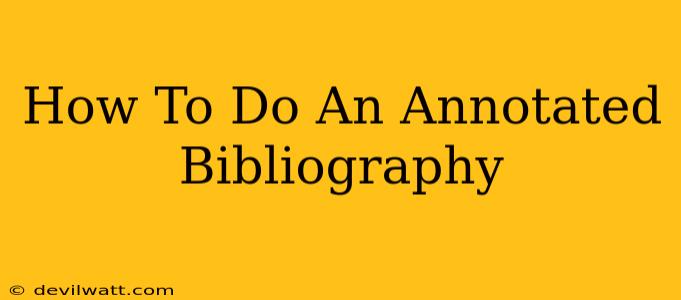Creating an annotated bibliography might seem daunting, but with a clear understanding of the process, it becomes manageable. This guide breaks down how to craft a strong annotated bibliography, enhancing your research skills and improving your academic work.
What is an Annotated Bibliography?
An annotated bibliography is more than just a list of sources. It's a curated collection of citations, each followed by a concise summary and evaluation of the source's relevance to your research topic. Think of it as a powerful tool that not only shows what sources you've consulted but also why they're important to your work. It demonstrates critical thinking and analytical abilities, key skills in any academic setting.
Steps to Creating a Stellar Annotated Bibliography
Here's a step-by-step process to guide you through the creation of a top-notch annotated bibliography:
1. Compile Your Sources
First, gather all the resources relevant to your research paper, essay, or project. This includes books, journal articles, websites, interviews – any source you've used or considered using. Maintain meticulous records of each source's details (author, title, publication date, etc.) to avoid errors later.
2. Create Accurate Citations
Following a consistent citation style (MLA, APA, Chicago, etc.) is paramount. Accuracy is crucial; a single mistake can undermine the credibility of your entire bibliography. Use citation management tools like Zotero or Mendeley to streamline the process and ensure consistency. Proper citation is essential for avoiding plagiarism.
3. Write Concise and Informative Annotations
This is where the real work begins. For each citation, you need to write a short annotation that typically includes:
- Summary: Briefly summarize the source's main argument or findings. What are the key takeaways?
- Evaluation: Critically assess the source. Is it reliable? Is the methodology sound? Does it support your research effectively? Consider the author's bias, the source's audience, and its overall contribution to your understanding of the topic.
- Relevance: Explain how the source specifically relates to your research question or thesis. What aspects of the source are most valuable to your work?
Example Annotation (APA Style):
Smith, J. (2023). The impact of social media on teenage mental health. Journal of Adolescent Research, 38(2), 150-175.
This article provides a comprehensive review of existing research on the relationship between social media use and adolescent mental well-being. Smith utilizes a meta-analytic approach, synthesizing data from numerous studies to identify consistent patterns and potential causal links. While the findings suggest a correlation between excessive social media use and increased anxiety and depression, the study acknowledges limitations in establishing direct causation. This source is crucial to my research because it offers a robust overview of the current state of knowledge and highlights areas requiring further investigation.
4. Organize and Format
Arrange your annotated bibliography alphabetically by author's last name. Maintain consistency in formatting, including font size, spacing, and indentation. Adhere strictly to your chosen citation style's guidelines.
5. Proofread Carefully
Before submitting your annotated bibliography, thoroughly proofread it for any errors in grammar, spelling, punctuation, or citation format. A polished, error-free bibliography reflects positively on your overall research.
Why is an Annotated Bibliography Important?
- Demonstrates Research Skills: It showcases your ability to locate, evaluate, and synthesize information from various sources.
- Saves Time: It provides a readily available summary of your sources, making the writing process smoother.
- Improves Writing Quality: The annotation process helps you clarify your understanding of the sources and how they connect to your research.
- Enhances Credibility: A well-crafted annotated bibliography strengthens the credibility and authority of your academic work.
By following these steps, you can master the art of creating an impressive and informative annotated bibliography. Remember, practice makes perfect! The more annotated bibliographies you create, the more proficient and confident you will become.

